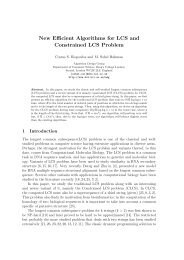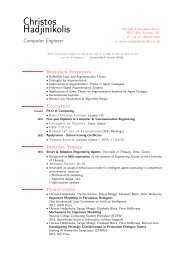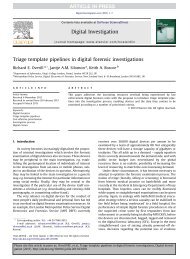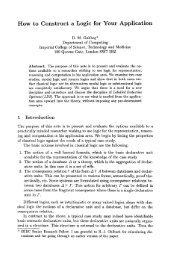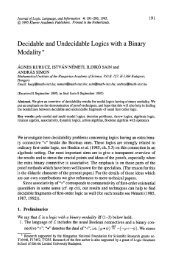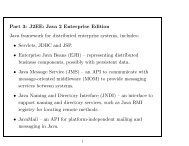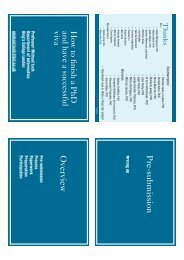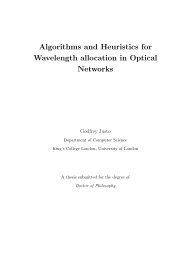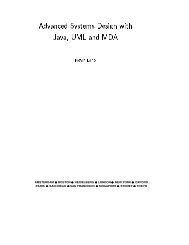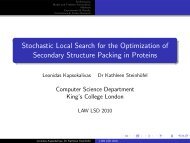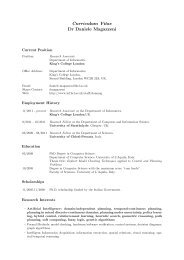Granular jamming with hydraulc control - King's College London
Granular jamming with hydraulc control - King's College London
Granular jamming with hydraulc control - King's College London
Create successful ePaper yourself
Turn your PDF publications into a flip-book with our unique Google optimized e-Paper software.
Finally, the conversion from shear stresses in Eqn. 2 to theexternal bending force F ext is as follows:F ext = τA (6)where A is the cross-sectional area of the joint.The values used to calculate the load force at the joint tip isoutlined in table 1. For the pneumatic system, the internal jointpressure level is set to 18 kPa (2.6 PSI-A) to reflect the pressureused in the experiments. Thus, σ was set to 83 kPa (12 PSI-A),resulting in a loading force of 0.43 N. For the hydraulic system,σ is estimated to occur at full water evacuation, and thusly set to101 kPa (14.6 PSI-A). This results in a force of 0.53 N, higherthan its pneumatic counterpart.FIGURE 2: Experimental setup for the hydraulic test. For thepneumatic experiments, a pressure sensor was attached to theport hole.METHODSHemispherical acrylic granules 1 mm in diameter were usedas the granular media. The variable stiffness joint membrane isa 0.2 mm thick latex cylinder 10 mm diameter by 30 mm longcylinder (2.36 mL volume). Because the Core-snake must largelyresist lateral disturbances, its perpendicular stiffness is most critical.As such, bending tests were performed. These tests consistof measuring the resulting force when deflecting the joint tip perpendicularlyto its axis by 10 mm. An ATI Nano17 Force/TorqueTABLE 1: Simulation ResultsHydraulicPneumaticF ext (N) 0.53 0.43τ (kPa) 6.73 5.53σ (kPa) 101 83A (mm 2 ) 78.5 78.5η H (kPa-s) 1 1˙γ (mm/s) 1 1µ k 0.2 0.2µ s 0.2 0.2P s (kPa) 33.7 27.7d (mm) 1ρ p (kg/m 3 ) 1180sensor measured the resultant force, and a Maxon EC-30 motorpowered linear module <strong>control</strong>led the deflection distance.The first experiment consisted of an air <strong>control</strong> test. Thisbaseline, <strong>control</strong> test was performed <strong>with</strong> an internal air pressureof 101 kPa (14.6 PSI absolute), which matches the external atmosphericpressure. The <strong>control</strong> test measures the lower boundof the joint’s stiffness, or its “soft” state. The upper bound of thepneumatic experiment consisted of continuously vacuuming thejoint to an internal air pressure of 18 kPa (2.6 PSI absolute). Thiswas achieved <strong>with</strong> a Mastercool 90066-2V-220 Vacuum Pumpattached to an intermediate 5.3 liter vacuum chamber. The internaljoint pressure was measured in-line by a Honeywell 0-30PSI Absolute pressure sensor. To compare the effectiveness of apneumatic system in an untethered environment, an air syringetest was performed. Here, 10 mL of air was evacuated via a syringe,and the resulting force was measured.The second experiment consisted of a water <strong>control</strong> test.This test is similar to the air <strong>control</strong> test, <strong>with</strong> the exception thatthe spaces between granules are filled <strong>with</strong> water, rather than air.The upper bound of the hydraulic experiment consisted of a 10mL syringe installed in place of the vacuum pump and evacuatingthe water <strong>with</strong>in the joint. 0.5 mL was water was evacuated toachieve a stiffened joint. The water used is known as deaired water,where water subjugated to a process of removing dissolvedair inside the liquid. Water was placed <strong>with</strong>in a vacuum chamberand vibrated, as the chamber pressure was decreased. This processwas done to ensure a uniform and consistent water density.While other hydraulic systems may use oil as the base stock, theuse of oil is outside the scope of this paper.This study examines the stiffness range and hysteresis of thesystems. The stiffness range is the maximum stiffness K max mi-3



